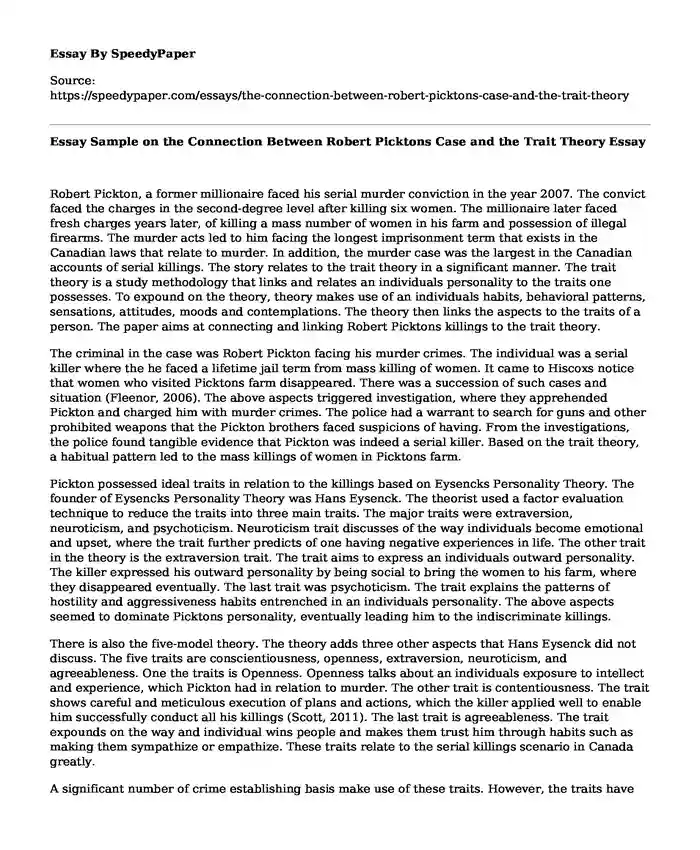
| Type of paper: | Essay |
| Categories: | Leadership analysis Criminal law Personality |
| Pages: | 3 |
| Wordcount: | 686 words |
Robert Pickton, a former millionaire faced his serial murder conviction in the year 2007. The convict faced the charges in the second-degree level after killing six women. The millionaire later faced fresh charges years later, of killing a mass number of women in his farm and possession of illegal firearms. The murder acts led to him facing the longest imprisonment term that exists in the Canadian laws that relate to murder. In addition, the murder case was the largest in the Canadian accounts of serial killings. The story relates to the trait theory in a significant manner. The trait theory is a study methodology that links and relates an individuals personality to the traits one possesses. To expound on the theory, theory makes use of an individuals habits, behavioral patterns, sensations, attitudes, moods and contemplations. The theory then links the aspects to the traits of a person. The paper aims at connecting and linking Robert Picktons killings to the trait theory.
The criminal in the case was Robert Pickton facing his murder crimes. The individual was a serial killer where the he faced a lifetime jail term from mass killing of women. It came to Hiscoxs notice that women who visited Picktons farm disappeared. There was a succession of such cases and situation (Fleenor, 2006). The above aspects triggered investigation, where they apprehended Pickton and charged him with murder crimes. The police had a warrant to search for guns and other prohibited weapons that the Pickton brothers faced suspicions of having. From the investigations, the police found tangible evidence that Pickton was indeed a serial killer. Based on the trait theory, a habitual pattern led to the mass killings of women in Picktons farm.
Pickton possessed ideal traits in relation to the killings based on Eysencks Personality Theory. The founder of Eysencks Personality Theory was Hans Eysenck. The theorist used a factor evaluation technique to reduce the traits into three main traits. The major traits were extraversion, neuroticism, and psychoticism. Neuroticism trait discusses of the way individuals become emotional and upset, where the trait further predicts of one having negative experiences in life. The other trait in the theory is the extraversion trait. The trait aims to express an individuals outward personality. The killer expressed his outward personality by being social to bring the women to his farm, where they disappeared eventually. The last trait was psychoticism. The trait explains the patterns of hostility and aggressiveness habits entrenched in an individuals personality. The above aspects seemed to dominate Picktons personality, eventually leading him to the indiscriminate killings.
There is also the five-model theory. The theory adds three other aspects that Hans Eysenck did not discuss. The five traits are conscientiousness, openness, extraversion, neuroticism, and agreeableness. One the traits is Openness. Openness talks about an individuals exposure to intellect and experience, which Pickton had in relation to murder. The other trait is contentiousness. The trait shows careful and meticulous execution of plans and actions, which the killer applied well to enable him successfully conduct all his killings (Scott, 2011). The last trait is agreeableness. The trait expounds on the way and individual wins people and makes them trust him through habits such as making them sympathize or empathize. These traits relate to the serial killings scenario in Canada greatly.
A significant number of crime establishing basis make use of these traits. However, the traits have strengths and weaknesses. To start with, the strengths, the theory has shown effectiveness in most of the cases of its application. In addition, behaviors, patterns and most traits discussed build ones personality and his or her actions in life. On the other side, the theory has a limitation. The theory puts much emphasis on leadership, where the contingency approach theory seems to overdo the trait theory.
References
Fleenor, J. (2006). Encyclopedia of Industrial and Organizational Psychology, Edition: First, Chapter: Trait Approach To Leadership, Publisher: Sage, Editors: SG Rogelberg, Pp.831-833. DOI: 10.13140/2.1.3091.2804 (Print).
Scott, D., Nahrgang, J., Carey, W., Wellman, N., Ross, S., and Humphrey, S. (2011). Trait and Behavioral Theories of Leadership: An Integration and Meta-Analytic Test of Their Relative Validity. Personnel Psychology Journal, Vol. 64, 752
Cite this page
Essay Sample on the Connection Between Robert Picktons Case and the Trait Theory. (2019, Nov 18). Retrieved from https://speedypaper.net/essays/the-connection-between-robert-picktons-case-and-the-trait-theory
Request Removal
If you are the original author of this essay and no longer wish to have it published on the SpeedyPaper website, please click below to request its removal:
- Essay Sample Describing Randomized Experiments in Psychology
- Budgeting Essay Sample for Your Free Use
- Management of People - HRM Essay Sample
- Compare and Contrast Essay Sample on the Works of Hawthorne and Poe
- Free Essay Sample on Social Media Enhance Political Campaigns
- Thinking Fast and Slow: Free Paper with An Annotated Bibliography Example
- Apple Tree Dental Program. Essay Example
Popular categories




